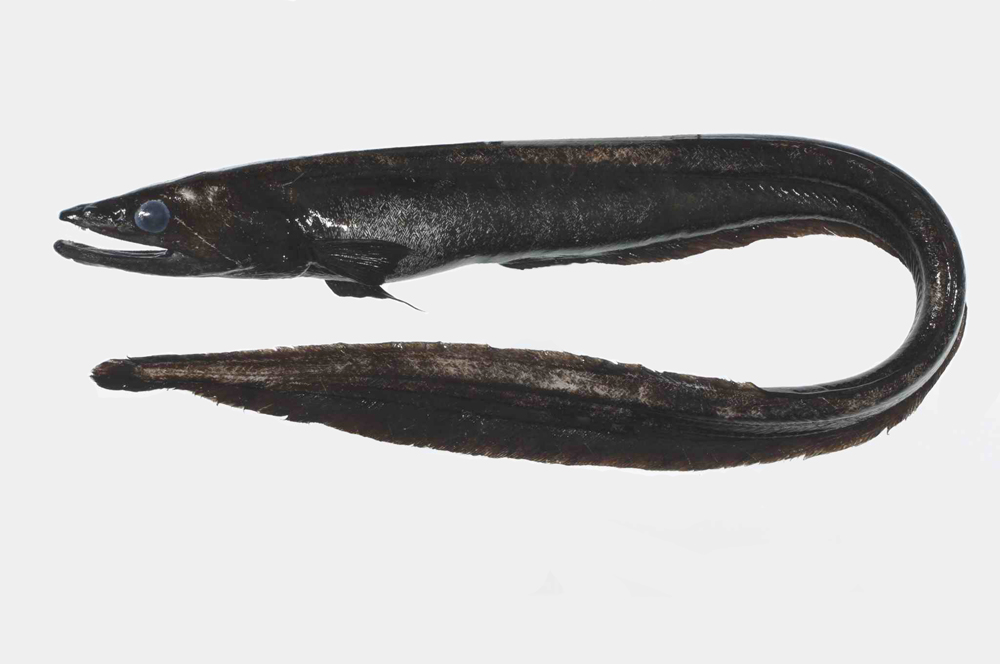Basketwork Eel, Diastobranchus capensis Barnard 1923
Other Names: Basket-work Eel, Deepsea Eel

Basketwork Eel, Diastobranchus capensis. Source: Robin McPhee & Mark McGrouther / NORFANZ Founding Parties. License: All rights reserved
Summary:
A dark brownish to purplish-black basketwork eel with the dorsal fin originating well behind the anus which is position forward on the body, and prominent falcate or curved pectoral fins.
Video of an aggregation of Basketwork Eels on Patience Seamount in the Huon Commonwealth Marine Reserve off southern Tasmania.
Video of an aggregation of Basketwork Eels on Patience Seamount in the Huon Commonwealth Marine Reserve off southern Tasmania.
Cite this page as:
Bray, D.J. 2020, Diastobranchus capensis in Fishes of Australia, accessed 29 Jun 2025, https://fishesofaustralia.net.au/home/species/1750
Basketwork Eel, Diastobranchus capensis Barnard 1923
More Info
|
Distribution |
Northeast of Forster (and possibly north to off Crowdy Head), New South Wales, to off Shark Bay, Western Australia, including Tasmania; also on the Lord Howe Rise, Norfolk Ridge in the Tasman Sea, and off Macquarie Island in the Southern Ocean. Elsewhere the species is southern circumglobal in temperate waters. Occurs on seamounts, ridges and rises on the continental slope. |
|
Features |
Dorsal fin ~360; Anal fin ~300; Caudal fin 16; Pectoral fin 16; Lateral line pores before anus ~27; Vertebrae 164-172. Body elongate, robust (depth approx. 7% TL), laterally compressed along tail; head moderately small (approx. 14% TL); eyes small; mouth moderately large, reaching beyond eye; teeth sharp, conical, in two rows on jaws anteriorly, those of inner row larger, merging into several rows on rear half of jaws; circular "premaxillary" patch of larger teeth, separate from single row of vomerine teeth with anteriormost teeth largest; gill openings large, oblique, before and below pectoral base. Scales tiny, very elongate, embedded, arranged in a conspicuous basketwork pattern; lateral-line pores inconspicuous, not associated with scales. Dorsal, caudal and anal fins confluent; dorsal-fin origin a head length behind level of anus. Pectoral fins prominent. Pelvic fins absent. |
|
Feeding |
A voracious predator of small fishes and crustaceans. |
|
Fisheries |
Taken as bycatch in deeper trawls and on deep drop lines on the continental slope. |
|
Remarks |
The eel is not uncommon in deeper hauls made by line or trawl on the continental slope, and is a well known by-catch species in New Zealand. |
|
Etymology |
The specific name capensis is for the type locality: Cape Point, South Africa. |
|
Species Citation |
Diastobranchus capensis Barnard 1923, Ann. S. Afr. Mus., 13(8): 441. Type locality: off Cape Point, South Africa, depth 470 fathoms.. |
|
Author |
Bray, D.J. 2020 |
|
Resources |
Basketwork Eel, Diastobranchus capensis Barnard 1923
References
Barnard, K.H. 1923. Diagnoses of new species of marine fishes from South African waters. Annals of the South African Museum 13(8): 439-444 See ref at BHL
Bruun, A.F. 1937. Contributions to the life histories of the deep sea eels: Synaphobranchidae. Dana Reports Dana Report No. 9: 1-31, Pl. 1 (described as Synaphobranchus danae)
Castle, P.H.J. 1975. Osteology and relationships of the eel Diastobranchus capensis (Pisces, Synaphobranchidae). Pacific Science 29: 159-163
Castle, P.H.J. 1986. Family 46: Synaphobranchidae. pp. 188-190 in Smith, M.M. & Heemstra, P.C. (eds). Smith's Sea Fishes. Johannesburg : Macmillan South Africa xx + 1047 pp. 144 pls.
Castle, P.H.J. 1994. Families Synaphobranchidae, Nettastomatidae, Ophichthidae. pp. 195-203 figs 172-179 in Gomon, M.F., Glover, C.J.M. & Kuiter, R.H. (eds). The Fishes of Australia's South Coast. Adelaide : State Printer 992 pp. 810 figs.
Crec'hriou, R., Zintzen, V., Moore, L. & Roberts, C.D. 2015. Length-weight relationships of 33 fish species from New Zealand. Journal of Applied Ichthyology 31: 558-561.
Fricke, R., Kulbicki, M. & Wantiez, L. 2011. Checklist of the fishes of New Caledonia, and their distribution in the Southwest Pacific Ocean (Pisces). Stuttgarter Beiträge zur Naturkunde. Serie A (Biologie) Neue Serie 4: 341-463
Gon, O. & Heemstra, P.C. (eds) 1990. Fishes of the Southern Ocean. Grahamstown : J.L.B. Smith Institute of Ichthyology 462 pp.
Karmovskaya, E.S. 2003. New records of synaphobranchid eels (Synaphobranchidae, Anguilliformes) collected off New Caledonia and adjacent regions, with description of a new species of Atractodenchelys. Journal of Ichthyology 43(7):491–500
Munro, I.S.R. 1961. Handbook of Australian fishes. Nos 1–42. Australian Fisheries Newsletter 15–17, 19, 20: 1-172 [published as separates 1956–1961] [44] (312, as Diastabranchus danae)
Smith, D.G. 1999. Family Synaphobranchidae. pp. 1658-1661 in Carpenter, K.E. & Niem, V.H. (eds). The Living Marine Resources of the Western Central Pacific. FAO Species Identification Guide for Fisheries Purposes. Rome : FAO Vol. 3 pp. 1397-2068. (as Synaphobranchus capensis)
Smith, D.G. 2008. Family Synaphobranchidae. pp. 160-166 in Gomon, M.F., Bray, D.J. & Kuiter, R.H. (eds). Fishes of Australia's Southern Coast. Sydney : Reed New Holland 928 pp.
Smith, D.G. & Stewart, A.L. 2015. 39. Family Synaphobranchidae. pp. 238-248 in Roberts, C.D., Stewart, A.L. & Struthers, C.D. The Fishes of New Zealand. Wellington : Te Papa Press Vol. 2 pp. 1-576.
Sulak, K.J. & Shcherbachev, Y.N. 1997. Zoogeography and systematics of six deep-living genera of synaphobranchid eels, with a key to taxa and description of two new species of Ilyophis. Bulletin of Marine Science 60(3): 1158-1194 See ref online
Williams, A., Althaus, F., Pogonoski, J., Osterhage, D., Gomon, M., Graham, K., Appleyard, S.A., Gledhill, D., Bray, D., McMillan, P., Green, M., Doyle, S., Graham, A., Tanner, J. & Ross, A. 2018. Composition, diversity and biogeographic affinities of the deep-sea (200–3000 m) fish assemblage in the Great Australian Bight, Australia. Deep-Sea Research II 157-168: 92-105. https://doi.org/10.1016/j.dsr2.2018.05.005
Williams, A., Last, P.R., Gomon, M.F. & Paxton, J.R. 1996. Species composition and checklist of the demersal ichthyofauna of the continental slope off Western Australia (20–35º). Records of the Western Australian Museum 18: 135-155




